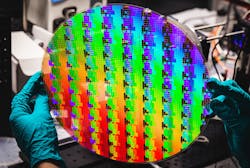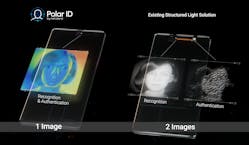Growing up, Rob Devlin, co-founder and CEO of Metalenz (Boston, MA), was inspired by watching his grandfather, a World War II radio operator and self-taught engineer, build things. Throughout his formative years, Devlin and his grandfather collaborated on assembling resistors, capacitors, and various other elements to create functional solutions, transforming disparate radio components into operational devices. As a teen, he turned to DIY skate ramp building, engineering elaborate and functional “skate parks” in his backyard.
These early experiences and interests helped lay the groundwork for Devlin’s career trajectory: Using material science and engineering to solve real-world applications with the best functional outcomes.
Leading with curiosity
Devlin chose to attend Drexel University to explore electrical engineering with a focus on semiconductor devices. Yet, after about two years in his undergraduate studies, he realized his passion was more around selecting the right materials with the right properties and engineering them for the best possible outcome—a mix of materials science and electrical engineering.
That focus grew as he moved into a master’s program. There, he leaped at the chance to take on an open-ended project working on materials. Even better, as the only student with an electrical engineering background in the lab, he was allowed to follow his intuition to explore potential scenarios, not restrained by existing technology and widening his vision beyond incremental results. Devlin thrived in this environment, where he could investigate scenarios that no one had previously looked at—and that sense of open discovery led him to pursue his Ph.D. at Harvard University.
At Harvard, one of his professors was renowned optics scientist Federico Capasso, who led a course on semiconductor device physics. While the course piqued Devlin’s interest, Capasso’s approach spoke to his investigative mind. Ahead of the lessons, Capasso posed a difficult open-ended question and then cold-called someone up to the board who would reason through it—not with math or the exact right equations and integrals, but with logic. Capasso set up an environment that allowed his students to produce ideas; that concept resonated with how Devlin thought of materials science and was fortuitous for his career development.
An idea is born
It was at Harvard that he first heard the term “metasurface,” opening a new realm of potential as he dove into metalenses and the optics behind them. Due to their bulky and complex structures, he saw how metamaterials could be nearly impossible to mass-produce. Yet, the concept of a metalens intrigued him, and he wanted to determine ways to overcome the mass production challenges.
In this exploration, Devlin focused on the idea of engineered materials. The concept of not being constrained to an existing set of materials but patterning them in a certain way to create a new function of the material incited additional exploration as the metamaterials market evolved.
Then, in 2016, Devlin and colleagues became the first to commercialize meta-optics by producing a metasurface that enabled high-quality images. Their results demonstrated a single nanometer-scale surface that showed similar image quality to 12-element microscopes that cost thousands of dollars. That discovery led to the launch of Metalenz.
A new player in town
As Devlin wrapped up his Ph.D. program, he considered continuing in academia, fueling his passion for open-ended questions and research. However, when his group published a paper on their results, they started hearing from the world’s largest cell phone companies, entrepreneurs, investors, and others, which emphasized the importance of their breakthrough. So, even before he’d defended his thesis, Devlin found himself supporting the launch of Metalenz, and in 2017, when he completed his Ph.D. program, he went full-time at the new startup.
The next few years were a whirlwind of entrepreneur partnerships and venture capital funding. But by 2020, Devlin was ready to assume the helm of CEO, driving the future of the technology. As any startup can attest, there are a lot of paths to consider when growing and evolving a company. But the seemingly limitless potential of metasurfaces compounded those possibilities at Metalenz. With literally thousands of directions to go, it took Devlin’s technical knowledge and curiosity to help set the course for the company’s future.
A thousand directions
Devlin credits the right timing to the strategic direction he was able to employ: The year they launched Metalenz is the year that face identification came out on Apple’s iPhone, introducing the first mass-market, narrowband imaging application. While augmented reality was also getting some early buzz, the team decided they wanted to get their technology into the market in an application where they knew they could provide benefits. So, the Metalenz team focused their resources on optical sensing systems.
That path led them to STMicroelectronics, which was already a leader in these devices from a fabrication perspective. What particularly piqued Devlin’s interest in STMicroelectronics was their vertical integration: Their manufacturing expertise, high-volume fabrication capabilities, and already differentiated product lines. As a partner, they understood the technology and would benefit directly. From that partnership, Metalenz launched a new optical technology, “meta-optics” into the consumer market for the first time.
That decision, it turned out, was the best choice for the company, as Metalenz earned commercial success quickly. There are plenty of examples of technologies going from a lab to scale for a product, but there are very few instances where it goes from lab to selling millions of units in the first two years. For the team, seeing their vision come to fruition in commercialization offered a validation of what this technology and this company could do.
A unique way of thinking
As Metalenz matured and acquired customers, Devlin realized that his propensity toward curiosity would serve him well. The company was in uncharted territory, and it quickly became apparent that customers didn’t have the language to explain what they needed. They would have a general idea of what they wanted in their system and could describe it at an elevated level, but always in the context of the incumbent technology, which, for Devlin’s team, could make it challenging to extract the maximum value of a meta-optics solution.
With that in mind, the team began speaking with customers differently, encouraging them to widen their perspective and think of the technology as a way to change their entire system. How do we replace and simplify? What are high-level pain points, and how can they be solved with a metasurface? Those questions drove Devlin and his team to the answers—ones where they could design a new system to address the issues. Because the technology was so new, the solution was often not something engineers would have been thinking about. So, the team shaped their customer discussions around references to designs built from the ground up around the metasurface.
A new biometric solution
Guided by this approach, the company continues to grow and expand, and so does its impact. For instance, most recently, Metalenz announced a new product that brings substantially simpler, secure biometric facial recognition to all smartphones. Called Polar ID, this product leverages polarization sensing to take facial information and apply it to secure identification.
Traditional 3D image sensors cannot capture this information, but metasurface optics can sort differently polarized photons to reveal much richer information about the scene. The unique “polarization signature” of a human face, for example, is inherently spoof-proof.
Historically, this type of polarization work would require tabletop-sized sensors found only in scientific labs and medical laboratories, but Metalenz’s technology has enabled chip-sized solutions that can be embedded into mobile and consumer devices for the first time—at a price point that supports market adoption.
Beyond being a significant new application, Devlin points out that this work introduces an entirely new form of sensing, one now accessible for a full spectrum of possibilities. For instance, polarization could apply to medical applications, such as potentially identifying cancerous cells on the skin or monitoring blood-sugar levels. It also may be applied to air quality monitoring, which the team finds exciting because it enables the optics and photonics community to evaluate how to leverage the technology to create new value. That open-ended potential is where Devlin sees Metalenz excelling in the future, offering a complete sensing platform for consumer devices.
Inspiring the next generation
In that same vein, Devlin has enthusiasm for cultivating the next generation of out-of-the-box thinkers, and he emphasizes the importance of education, crediting his Ph.D. program with training him to learn.
He also counsels that it’s not always easy. For every win the company has had, they have had a wide range of misses. While Metalenz has been very fortunate to have early commercial success, Devlin recalls hundreds and hundreds of hours of moving things down the wrong path before ultimately driving Metalenz to where it is today.
Though assuming business leadership for the company could consume all of Devlin’s time, he continues to be involved in developing the technology because it serves as the foundation for why he does what he does. While Metalenz has a team of designers and engineers leading technology development, spending time talking with them, conducting measurements, and generally getting the chance to be hands-on connects him back to why he started this work in the first place: his passion for materials science.
Devlin has already come far—from building radios and skate ramps to the Capasso lab at Harvard and now the CEO chair at Metalenz. Throughout his life, a continuous curiosity, thirst for knowledge, and focus on problem-solving propelled and directed his career. These are the same traits that continue to fuel Metalenz’s success.


